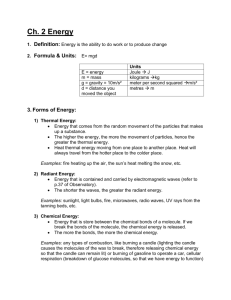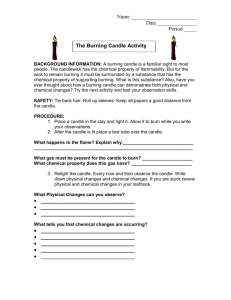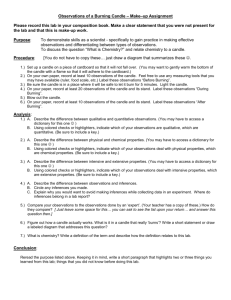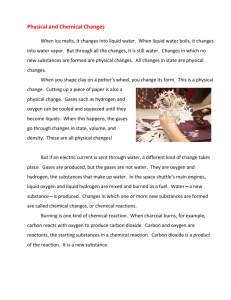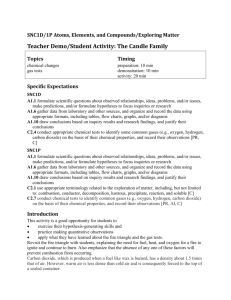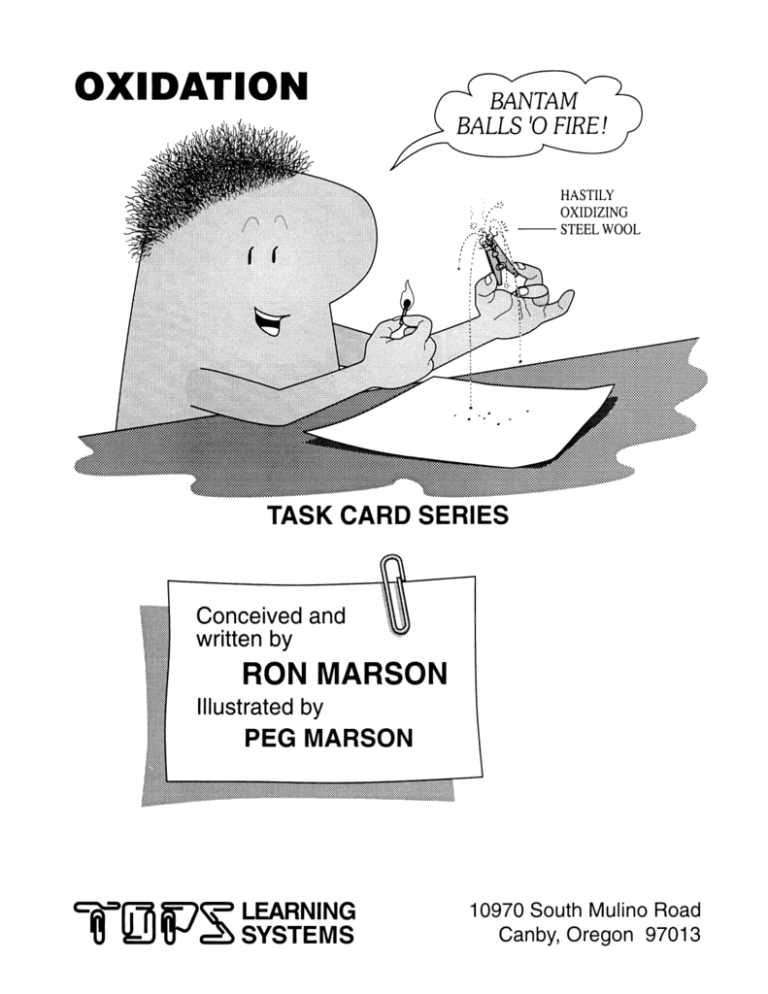
OXIDATION
BANTAM
BALLS '0 FIRE!
HASTILY
OXIDIZING
-STEELWOOL
TASK CARD SERIES
\,
Conceived and
written by
RON MARSON
Illustrated by
PEG MARSON
9r~ 2f7~ LEARNING
U ~ '\t' cd) SYSTEMS
10970 South Mulino Road
Canby, Oregon 97013
WHAT CAN YOU COPY?
Dear Educator,
Please honor our copyright restrictions. We offer liberal options and guidelines below
with the intention of balancing your needs with ours. When you buy these labs and use
them for your own teaching, you sustain our work. If you “loan” or circulate copies to
others without compensating TOPS, you squeeze us financially, and make it harder for
our small non-profit to survive. Our well-being rests in your hands. Please help us keep
our low-cost, creative lessons available to students everywhere. Thank you!
PURCHASE, ROYALTY and LICENSE OPTIONS
TEACHERS, HOMESCHOOLERS, LIBRARIES:
SCHOOLS, DISTRICTS, and HOMESCHOOL CO-OPS: .
We do all we can to keep our prices low. Like any
business, we have ongoing expenses to meet. We
trust our users to observe the terms of our copyright
restrictions. While we prefer that all users purchase
their own TOPS labs, we accept that real-life situations sometimes call for flexibility.
PURCHASE Option: Order a book in quantities equal to the number of target
classrooms or homes, and receive quantity discounts. If you order 5 books or downloads, for example, then you have unrestricted use of this curriculum for any 5 classrooms or families per year for the life of your institution or co-op.
2-9 copies of any title: 90% of current catalog price + shipping.
10+ copies of any title: 80% of current catalog price + shipping.
Reselling, trading, or loaning our materials is
prohibited unless one or both parties contribute an
Honor System Royalty as fair compensation for value
received. We suggest the following amounts – let
your conscience be your guide.
ROYALTY / LICENSE Option: Purchase just one book or download plus photocopy or printing rights for a designated number of classrooms or families. If you pay
for 5 additional Licenses, for example, then you have purchased reproduction rights
for an entire book or download edition for any 6 classrooms or families per year for
the life of your institution or co-op.
1-9 Licenses: 70% of current catalog price per designated classroom or home.
10+ Licenses: 60% of current catalog price per designated classroom or home.
HONOR SYSTEM ROYALTIES: If making copies from a library, or sharing copies with colleagues,
please calculate their value at 50 cents per lesson,
or 25 cents for homeschoolers. This contribution may
be made at our website or by mail (addresses at the
bottom of this page). Any additional tax-deductible
contributions to make our ongoing work possible will
be accepted gratefully and used well.
Please follow through promptly on your good intentions. Stay legal, and do the right thing.
WORKSHOPS and TEACHER TRAINING PROGRAMS:
We are grateful to all of you who spread the word about TOPS. Please limit copies
to only those lessons you will be using, and collect all copyrighted materials afterward. No take-home copies, please. Copies of copies are strictly prohibited.
Ask us for a free shipment of as many of our TOPS IDEAS Catalogs as you
need to support your efforts. Every catalog is a rich, attractive resource magazine
packed with free sample teaching ideas.
Electronic edition 2011. Copyright © 1995 by TOPS Learning Systems. Revised edition published 2005. All rights
reserved. This material is created/printed/transmitted in the United States of America. No part of this program may be used,
reproduced, or transmitted in any manner whatsoever without written permission from the publisher, except as explicitly
stated above and below:
The original owner of this book or digital download is permitted to make multiple copies of all student materials for personal teaching use, provided all reproductions bear copyright notice. A purchasing school or homeschool co-op may assign
one purchased book or digital download to one teacher, classroom, family, or study group per year. Reproduction of student
materials from libraries is permitted if the user compensates TOPS as outlined above. Reproduction of any copyrighted materials for commercial sale is prohibited.
For licensing, honor system royalty payments, or catalog requests, contact: www.TOPScience.org; or
TOPS Learning Systems, 10970 S Mulino Rd, Canby OR 97013; or inquire at tops@canby.com
ISBN 978 - 0 - 941008 - 81 - 5
CONTENTS
CiM{~)
INTRODUCTION
A. A TOPS Model for Effective Science Teaching
C. Getting Ready
D. Gathering Materials
E. Sequencing Task Cards
F. Long Range Objectives
G. Review / Test Questions
CiID"jt»
TEACHING NOTES
CORE CURRICULUM
1. Candle Combustion
2. Human Respiration
3. I Feel Faint
4. Bottom Burner
5. It's a Gas
6. Limewater Reaction
7. Three Little Jars
8. Chemical Overview
9. Glowing Splint
10. Iron Rusts
11. Percent Oxygen?
ENRICHMENT CURRICULUM
12. Does Iron Burn?
13. Chemistry Puzzle
14. What's Your Hypothesis?
15. Reproducible Results?
16. Isopropyl Investigation
(pU)
REPRODUCIBLE MATERIALS
Task Cards 1-16
Gathering Materials
Listed below is everything you'll need to teach this module. You already have many of these items. The rest are
available from your supermarket, drugstore and hardware store. Laboratory supplies may be ordered through a science
supply catalog.
Keep this classification key in mind as you review what's needed:
special in-a-box materials:
general on-the-shelf materials:
Italic type suggests that these materials are unusual.
Keep these specialty items in a separate box. After you
finish teaching this module, label the box for storage and
put it away, ready to use again the next time you teach this
module.
Normal type suggests that these materials are
common. Keep these basics on shelves or in drawers
that are readily accessible to your students. The next
TOPS module you teach will likely utilize many of these
same materials.
(substituted materials):
*optional materials:
Parentheses enclosing any item suggests a ready
substitute. These alternatives may workjust as well as the
original, perhaps better. Don't be afraid to improvise, to
make do with what you have.
An asterisk sets these items apart. They are nice to
have, but you can easily live without them. They are
probably not worth an extra trip to the store, unless you
are gathering other materials as well.
Everything is listed in order of first use. Start gathering at the top of this list and work down. Ask students to bring
recycled items from home. The teaching notes may occasionally suggest additional student activity under the heading
"Extensions." Materials for these optional experiments are listed neither here nor in the teaching notes. Read the extension
itself to find out what new materials, if any, are required.
Needed quantities depend on how many students you have, how you organize them into activity groups, and how you
teach. Decide which of these 3 estimates best applies to you, then adjust quantities up or down as necessary:
Ql' Q2' Q 3
y-=--+ Single Student: Enough for 1 student to do all the experiments.
L
Individualized Approach: Enough for 30 students informally working in 10 lab groups, all self-paced.
Traditional Approach: Enough for 30 students organized into 10 lab groups, all doing the same lesson.
KEY:
1/10/10
.1/1/1
4/40/40
1/10/10
2/20/20
1/10/10
1/10/10
1/1/1
1/10/10
1/10/10
1/10/10
1/10/10
2/20/20
1/10/10
1/10/10
1/10/1 0
1/10/10
1/10/10
1/2/4
2/20/20
1/4/10
1/1/1
1/1/1
1/2/2
1/10/10
special in-a-box materials
(substituted materials)
general on-the-shelf materials
*optional materials
2/20/20
1/1/1
1/1/1
1/1/1
1/2/10
1/1/1
1/2/2
1/10/10
1/3/10
1/1/1
1/1/1
2/15/20
1/3/10
1/10/10
1/2/10
1/3/10
1/1/1
1/10/10
1/3/10
1/3/10
1/1/1
1/3/10
1/1/1
1/10/10
1/2/10
pkgs birthday candles, not dripless
cup modeling clay
tall baby food jars, 6 ounce size
pint jars with lids
books matches
household candles - see notes 1
tuna fish cans for match disposal
wall clock (watch with a second hand)
empty toilet paper rolls
scissors
plastic produce bags
plastic sandwich bags
rubber bands
rubber tubes, at least .5 cm dia and 30 cm long
rolls masking tape
large tubs
pieces easy-to-bend wire, at least 30 cm long
metric rulers
*wire cutters
size-D batteries, dead or alive
tablespoons
bottle vinegar
box baking soda
rolls paper towels
*index cards
D
medium test tubes
source of water and sink or large tub
pkg calcium hydroxide - see notes 6
roll plastic wrap
teaspoons
pkgs active dry yeast - see notes 9
bottles hydrogen peroxide
Popsicle sticks
graduated cylinder, 100 mL size
pkg fine-grade, pure steel wool balls
bottle chlorine bleach
wooden clothespins
*hand calculators
*Iarge test tubes
medium-sized nails
magnets
roll aluminum foil
medium-sized washers
plastic lids from margarine tubs
quart jars
bottle liquid soap
shallow saucers
bottle 70% isopropyl alcohol- see notes 16
eye droppers and * eye-dropper bottles
dictionaries
Sequencing Task Cards
This logic tree shows how all the task cards in this module tie together. In general,
students begin at the bottom of the tree and work up through the related branches. As the
diagram suggests, upper level activities build on lower level activities.
At the teacher's discretion, certain activities can be omitted, or sequences changed,
to meet specific class needs. The only activities that must be completed in sequence are
indicated by leaves that open vertically into the ones above them. In these cases the lower
activity is a prerequisite to the upper.
When possible, students should complete the task cards in the same sequence as
numbered. If time is short, however, or certain students need to catch up, you can use the logic
tree to identify concept-related horizontal activities. Some of these might be omitted, since
they serve only to reinforce learned concepts, rather than introduce new ones.
On the other hand, if students complete all the activities at a certain horizontal concept
level, then experience difficulty at the next higher level, you might move back down the logic
tree to have students repeat specific key activities for greater reinforcement.
For whatever reason, when you wish to make sequence changes, you'll find this logic
tree a valuable reference. Parentheses in the upper right corner of each task card allow you
total flexibility; they are left blank so you can pencil in sequence numbers of your own
choosing.
E
Review I Test Questions
Photocopy the questions below. On a sheet of blank paper, cut and paste those questions you want to use in your test.
Include questions of your own design, as well. Place all these questions on a single page for students to answer on another
paper, or leave space for student responses after each question, as you wish. Duplicate a class set and your custom-made
test is ready to use. Use leftover questions as a review in preparation for the final exam.
tasks 1,3,4
Small fires may be put out be covering
them with a blanket. Why is this
effective?
tasks 1-3
You are sealed in a small cave by a
landslide that has covered your exit
route. Rescue workers have brought
in heavy equipment to dig you out,
but it will probably be many hours
before you see the light of day. A
candle and matches are in your
backpack. You think about lighting
the candle to chase away the
darkness. Should you?
tasks 1-3, 9-13
What do a burning candle, a living
person and a rusting nail have in
common?
tasks 4-5
A candle
burns at
the bottom
of a small
jar like this.
task 6
You pour carbon dioxide gas into a
jarof limewater, cap the top with your
hand, and shake it. Why does the jar
stick to your hand?
a. Draw convection currents
associated with the burning candle.
b. You add vinegar and baking soda
to the jar without touching the flame or
getting it wet. Will the candle go out?
Explain.
task 5
Carbon dioxide is a good fire
extinguisher. Explain why.
tasks 5-12
Three trays are filled with test tubes
containing these gases.
tasks 6-7
Plants consume carbon dioxide.
Design a demonstration to show that
this is so. Include both an experiment
and a control.
task 8
a. Write a balanced equation for the
combustion of candle wax (C 28 HS8).
b. Write a balanced equation for the
oxidation of glucose (C a H 12 Oa).
tasks 8,10
Copper (Cu) has a shiny metallic
luster, while copper oxide (CU20)
looks dull brown.
a. How does the appearance of a
new penny change with age? Why?
b. Write a balanced equation.
task 3
You wish to transfer some oxygen
gas from a large bottle to a small test
tube. Diagram how to do this.
task 4
You are facing an immense prairie
fire, with a huge wall of fire rising
straight up toward the sky. Which
way do you feel the wind blowing?
Why?
Copyright © 1995 by TOPS Learning Systems.
task 8,16
Write a balanced equation for the
combustion of methane gas (CH4).
a. Explain how to use a burning splint
to verify that each box is correctly
labeled.
b. How would you use limewater to
identify each gas?
c. Steel wool?
G
Review I Test Questions (continued)
task 9
tasks 10-11 C
tasks 14-15 A
Explain how to use a glowing splint to
decide whether a jar of unknown gas
contains abundant oxygen.
A company sells cylinders of gas,
claiming that they contain 50%
oxygen. How might you test this claim
by experiment?
A glass tube has one end sealed with
a balloon membrane. The open end
is lowered over a burning candle and
stuck into a "pancake" of clay, forming
an airtight seal.
tasks 10-11 A
Describe what happens when a nail
rusts.
tasks 10-11 B
Suppose you put wet steel wool in
each test tube, fill them with oxygen,
room air, or carbon dioxide as shown,
then seal airtight with balloon
membranes and rubber bands.
Redraw this diagram showing how
each test tube might look after several
weeks. Give reasons to support each
prediction.
tasks 10,11,14,15
Three pieces of steel wool were
dipped in oil, and anotherthree pieces
were left untreated. They were placed
in test tubes (in various positions)
and inverted over water. After 24 hours
the water levels rose only in the test
tubes that contained untreated steel
wool.
OIL TREATED
UNTREATED
MEMBRANE
GLASS
TUBE
CLAY SEAL
a. Will the membrane bulge out?
Why?
b. Will the membrane be drawn in?
Why?
tasks 14-15 B
A good scientists is always ready to
replace a gQQd hypothesis with a
better one. Why not just start out with
the best hypothesis and be done with
it?
OXYGEN
ROOM
AIR
CARBON
DIOXIDE
a. Why did water rise in some of the
tubes, but not others?
b. Identify an important variable in
this experiment that affected the
results.
c. Identify an unimportant variable in
this experiment that did not affect the
results.
d. All important variables in this
experiment are controlled. How do
you know?
task 12
You are assigned the task of burning
a nail. Explain how to do it.
tasks 12-13
Is iron oxide magnetic?
Copyright © 1995 by TOPS Learning Systems.
task 15
Burning candles are placed under
different sized containers as
illustrated.
a. Identify 2 important variables in
this experiment.
b. Why is it difficult to predict which
candles will go out first?
task 16
Design a demonstration to show that
a car engine produces carbon dioxide
and water vapor when it burns
gasoline.
Task Objective (TO) discover that candles require a constant supply of oxygen to burn. To understand this
process as an energy-producing oxidation reaction.
o
CANDLE COMBUSTION
1. Stand 2 birthday candles
in small lumps of clay.
Put one next to
a small jar, the
other next to
a large jar.
Oxidation (
)
2. Light the candles, then
setajarovereach
one at the same
time. Write
your observations.
~
~
3. Blow fresh air into each jar, and repeat the experiment. Time how long each
candle burns inside each jar.
4. Combustion (burning) is a process that uses up both fuel and oxygen.
a. Compare a new candle with a used one. What fuel is being consumed?
b. Why do burning times vary with jar size?
5. When a fuel burns, it oxidizes (combines with oxygen).
a. What gets oxidized in this experiment?
b. Does this oxidation reaction absorb energy or release energy? Explain.
©
1995 by TOPS Learning Systems
Introduction
Light a candle. Observe how a piece of paper (like hair and clothing)
can catch fire at a distance. Discuss the safe and responsible use of
open flames, disposal of hot matches, etc.
1
Answers I Notes
2. Both covered candles burn for a little while, then go
out. The candle covered by the large jar burns longer
than the candle covered by the small jar.
3. Expect variations up to several seconds depending on
the size of the candle flame and how thoroughly used air
is purged from each container. Here is one result:
6 oz. baby food jar: candle burned 7 seconds
pint jar: candle burned 16 seconds
4a. A used candle is shorter than a new one. This implies
that candle wax is the fuel that gets consumed.
4b. The candle burns for a longer time in the larger jar
because it contains more oxygen than the smaller jar.
(Air is a mixture of gases that include oxygen. For now,
these words can be used interchangeably. Theirdistinction will emerge naturally over time.)
Sa. Candle wax gets oxidized as it burns.
Sb. This oxidation reaction releases energy in the form
of heat and light.
notes 1
Materials
D Birthday candles. Avoid the dripless variety
with hollow centers.
D Modeling clay.
D A small jar. We recommend using a tall 170 g
(6 ounce) baby food jar. Smaller sizes may not
provide enough "head room"forthe burning candle.
D A large jar, pint or quart size.
D Matches.
D A household candle (optional). Keeping 1
continuously lighted pilot candle in an accessible
place will dramatically reduced match consumption.
D A tuna fish can or other shallow container for
the safe disposal of used matches.
A wall clock or a watch with a second hand.
o
Task Cards Options
Here are 3 management options to consider before you photocopy:
1. Consumable Worksheets: Copy 1 complete set of task card
pages. Cut out each card and fix it to a separate sheet of boldly lined
paper. Duplicate a class set of each worksheet master you have
made, 1per student. Direct students to followthe task card instructions
at the top of each page, then respond to questions in the lined space
underneath.
2. Nonconsumable Reference Booklets: Copy and collate the 2up task card pages in sequence. Make perhaps half as many sets
as the students who will use them. Staple each set in the upper left
corner, both front and back to prevent the outside pages from
working loose. Tell students that these task card booklets are for
reference only. They should use them as they would any textbook,
responding to questions on their own papers, returning them
unmarked and in good shape at the end of the module.
3. Nonconsumable Task Cards: Copy several sets of task card pages.
SrUD£Nr
TASk CA/U"5
1
Laminate them, if you wish, for extra durability, then cut out each card to
display in your room. You might pin cards to bulletin boards; or punch out the
holes and hang them from wall hooks (you can fashion hooks from paper
clips and tape these to the wall); or fix cards to cereal boxes with paper
fasteners, 4 to a box; or keep cards on designated reference tables. The
important thing is to provide enough task card reference points about your
classroom to avoid a jam of too many students at anyone location. Two or
3 task card sets should accommodate everyone, since different students will
use different cards at different times.
o
CANDLE COMBUSTION
1. Stand 2 birthday candles
in small lumps of clay.
~
Put one next to
~
asmalljar, the
other next to
a large jar.
Oxidation (
)
2. Light the candles, then
setajarovereach
one at the same
time. Write
your observations.
3. Blow fresh air into each jar, and repeat the experiment. Time how long each
candle burns inside each jar.
4. Combustion (burning) is a process that uses up both fuel and oxygen.
a. Compare a new candle with a used one. What fuel is being consumed?
b. Why do burning times vary with jar size?
5. When a fuel burns, it oxidizes (combines with oxygen).
a. What gets oxidized in this experiment?
b. Does this oxidation reaction absorb energy or release energy? Explain.
© 1995 by TOPS Learning Systems
o
HUMAN RESPIRATION
Oxidation (
)
~'u~~~r~~ned~h~~~~~~ ~f~~~~~~I~~Ob~9ea~~~ln~~~:: ~ ~1riDWICH
a plastic produce bag around the other.
2. Take a deep breath and hold your nose.
Breathe in and out through your mouth, as
normally as possible, into the larger bag.
a. Look at a clock. How long can you use the
same air over and over before you feel uncomfortable?
b. How did your breathing change over time?
c. Did you collect anything in the bag besides "used" air?
3. Now exhale fully into the small bag, allowing
4. A candle oxidizes wax.
excess air to leak past the mouthpiece. Once
a. What do you think
again, hold your nose and breathe through your
you oxidize?
mouth as normally as possible.
b. Does the oxidation
a. How long did you rebreathe the same air?
reaction in your body
Compare this result with step 2a.
absorb
or release
b. Compare human respiration (breathing) to
energy? Explain.
candle combustion.
©
1995 by TOPS Learning Systems
cards 1-2
2



